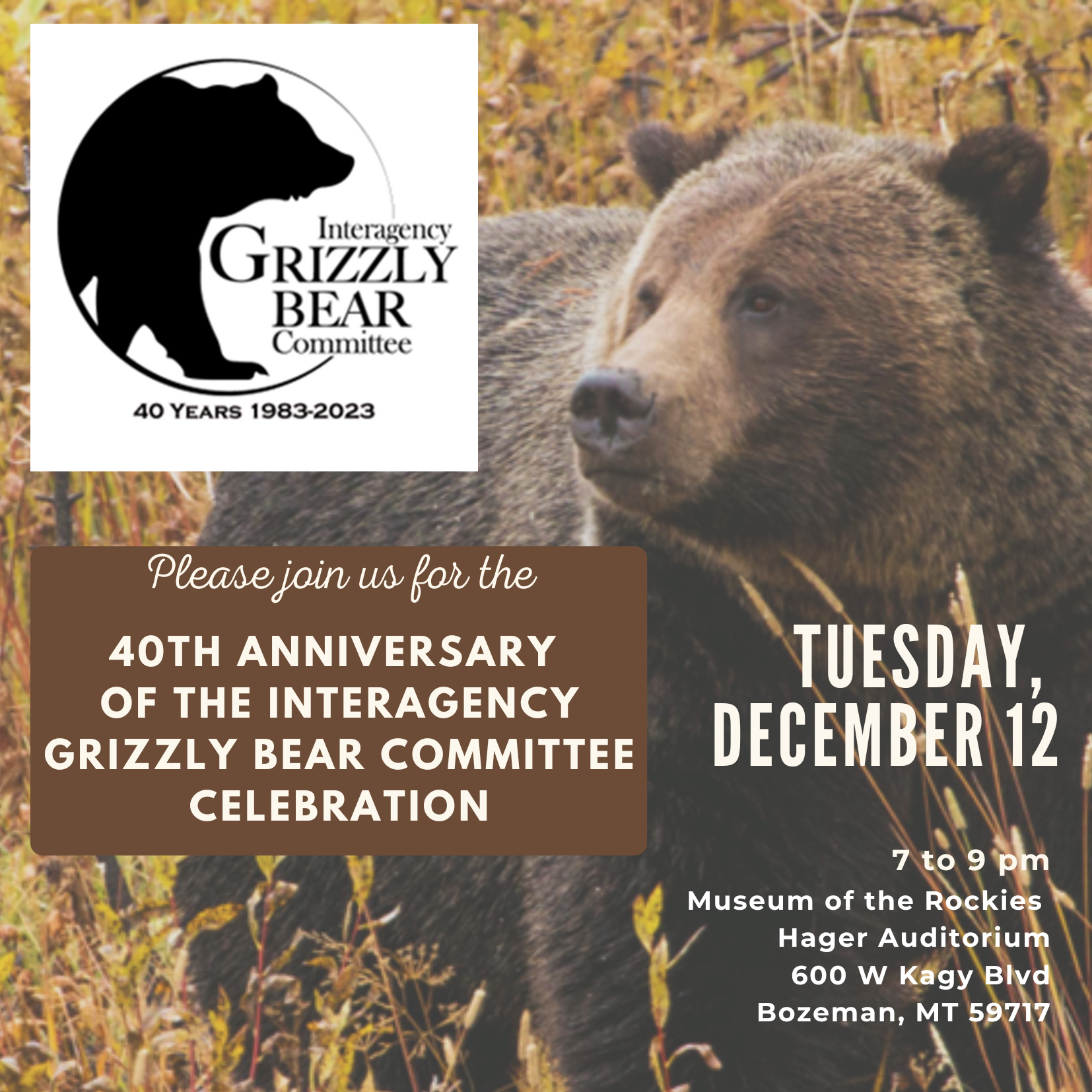December 12, 2023
The IGBC is celebrating four decades of collaborative efforts. Watch the Facebook live here: https://fb.me/e/7tuY16eTV.
The event will be held on Tuesday, Dec. 12 at the Museum of the Rockies in Bozeman, Montana. The public is invited to attend from 7-9 p.m. inside the Hager Auditorium. The event is free to the public with first-come, first-served seating. The evening will include a panel discussion with past and present grizzly bear experts from across the region who will share stories and reflect on the progress of the last 40 years.
“The recovery of grizzly bears in the lower 48 states is a conservation success story, and it underscores what can be achieved through effective collaboration,” said Jim Fredericks, IGBC Chair, and Director of Idaho Department of Fish and Game. “We are proud to reach this 40th anniversary, and we want the public to get a chance to hear from some of our dedicated scientists and managers who have devoted their careers to this effort.”
The IGBC has proven to be a successful model for agencies working cooperatively and coordinating recovery efforts over multiple jurisdictions, and substantial progress has been made toward recovering the species. In 1975, biologists estimated that as few as 700 – 800 grizzlies survived in the lower 48 states and that the population was declining. Today, biologists estimate there are more than 2,200 grizzly bears across four populations. The populations centered on Yellowstone and Glacier national parks are stable and increasing, and every year we see bears in places that they have not been in a hundred years.
The event will also highlight the importance of partnerships such as the IGBC’s Bear-Resistant Products Testing Program, which promotes effective food storage in bear country by evaluating products designed to reduce human-bear conflicts and increase public safety. IGBC began providing guidance and direction relative to bear-resistant containers in the 1980s with a goal of ensuring effective storage of attractants and minimizing human/grizzly bear conflicts. The testing program is a partnership with the Grizzly & Wolf Discovery Center, the Washington State University Bear Center, and the Wildlife Management Institute. To date, the IGBC has approved nearly 500 products from more than 100 manufacturers.
“Conservation success creates new challenges,” said David Diamond, IGBC Executive Coordinator. “Partnerships are critical to reduce conflicts and improve human safety in areas where people and bears share the landscape.”
The IGBC consists of representatives from the U.S. Fish and Wildlife Service, U.S. Forest Service, the National Park Service, the Bureau of Land Management, the U.S. Geological Survey, and representatives of the state wildlife agencies of Idaho, Montana, Washington, and Wyoming. Native American tribes that manage grizzly bear habitat and county governments are also represented, along with other partners. The IGBC was formed in 1983 to focus on the recovery of grizzly bear populations and their habitat through interagency coordination of policy, planning, management, research, and education.
###
FACT SHEET
Since it was founded in 1983, the IGBC has:
- Established and maintained Ecosystem Subcommittees in five grizzly bear ecosystems in Idaho, Montana, Washington, and Wyoming, the four western states in which grizzly bears currently exist: the Northern Continental Divide Ecosystem, the Bitterroot Ecosystem, the Yellowstone Ecosystem, the North Cascades Ecosystem, and the Selkirk Cabinet-Yaak Ecosystem. The IGBC regularly holds public meetings across the ecosystems to provide a forum information about grizzly bear management and conservation.
- Developed Grizzly Bear Conservation Strategies for the Northern Continental Divide Ecosystem and Greater Yellowstone Ecosystem. A conservation strategy for the Selkirk and Cabinet-Yaak Ecosystems is in development.
- Supported the Interagency Grizzly Bear Study Team and other world-class scientific efforts to learn more about grizzly bears and what they need to survive.
- Established an active and effective presence in education and outreach about grizzly bears. The IGBC’s web site (IGBConline.org) provides the public with accurate information about grizzly bears, the IGBC, the ecosystem subcommittees, their activities, scientific publications and studies, and how to avoid or minimize bear-human conflicts. The IGBC annually awards more than $42,000 in grants to help partners and agencies to disseminate consistent messages about grizzly bears and to promote effective actions and techniques to increase human safety and decrease the likelihood of a human-bear conflict.
- Conducted in-depth research into the effectiveness and efficacy of several bear-related developments and products such as bear deterrent sprays, bear-resistant food and garbage containers, and portable electric fences to restrict bear access to attractants.
- The IGBC has recently developed and published a framework and manual for the Bear Smart Communities program, which supports collaborative community-led strategies that benefit both people and bears by reducing conflicts and improving human safety in areas where people and bears share the landscape.
###


